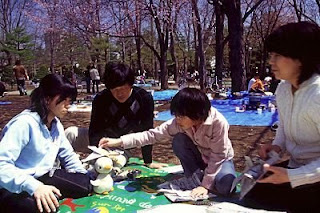
One mistake I see a lot of beginner photographers make is to use their cameras as something to capture only the final image. They sit and wait for things to happen and then take a photograph when they think the peak moment happens.
When you're telling a story you need to use your camera like a sketch pad. A warm-up exercise. Looking through the viewfinder and pushing the shutter button actually gets you in the mood and prepares you for when the action starts happening.
Taking a series of shots helps refine your visual sense and work out your composition. This shot here is a kind of warm-up. It shows the girls preparing the spot for the picnic.
As you can see it's all bare dirt and surrounded by other tarpaulins and bare trees. I didn't think it would make the book but it helped me warm up and get a sense of how I wanted to photograph what was to come. It also helped me to look through the viewfinder and see how the background cherry trees looked in the picture - not good from this angle.

Again luck was on our side because it was already pretty crowded at Maruyama Park (people get their at first light to reserve a spot) but we managed to get a spot under one of the fullest blooms in the whole park. Only one though as the other trees were fairly bare so it really limited the angle I could shoot from.
Being a first-timer at the cherry blossoms with a family I wasn't really sure about how things went so I talked to the girls and they decided that making traditional samurai hats and swords out of newspaper was a traditional cherry blossom festival activity.
They kind of thought that it was more of a boy thing but also agreed that it sounded like a lot of fun so they made them for me and I got Haruna

to pose underneath the lovely blossoms. As well as action shots I was looking for some nice portrait shots so this one fit the bill nicely.
Of course when the photos were over they couldn't resist beating the hell out of each other! Of course it wasn't a book on wrestling so I knew it wouldn't make the cut but, again more visual exercises. Photographing it helped get me in the mood for photographing fast action when I needed to.

Now in case you're wondering, of course there is a Dad! Mr N was helpfully parking the car in some obscure carpark a million miles away - because Japan is known for its traffic.
He was able to join us a bit later and I did some group shots of the family to set the scene. You'll notice that we haven't seen any food yet. That's because in order to get a spot under the trees we'd had to get there way too early for anybody to even think about eating!
So we had some time to kill and tomorrow you'll see how we did it.
Photographically what I'd like you to notice is the light. It's really harsh and contrasty. Not as bad as you get out here in Australia but still very strong. You can see big shadows everywhere and I had to be very careful with my exposures.
When you have such strong contrast you tend to either lose details in the highlights or the shadows. Mostly because I wanted to retain that lovely blue sky and the pink of the cherry blossoms I decided to keep my exposure darker and lose details in the shadows. In any of the pics you can see big, dark inky parts.
But you'll also notice that the faces are quite bright. The answer here is flash. I have my flash pretty much permanently on during bright sunny days. That's right - leave the flash on on a sunny day. Flash will help lighten those shadows. It actually fills them with light and that's why we call it fill flash. You have to be reasonably close to your subject for it to work but, even with a little point and shoot, the flash can be quite powerful and you always want to have it on on a bright sunny day when photographing people.
The other thing you'll notice is that I've pretty much kept myself low for a lot of the photographs. The first set-up shot shows what happened when I was standing - shooting down meant lots of ugly dirt and not many pretty trees. So I kept myself either sitting or lying on the ground so that I could shoot up, avoid the dirt and get more trees and beautiful blue sky in.
 Hi there everybody,
Hi there everybody,









.JPG)

































